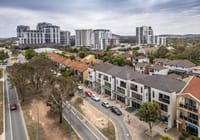
Australia's buildings debate focuses on height, not quality, Brent Toderian says
Australian cities are getting poor buildings because the debate about them starts and ends with building height, one of Canada’s highest-profile urban planners says.
Rather than considering the design of a building and the effect it would have on its location, the debate about better density was being hijacked by simplistic arguments about height, Vancouver’s former chief planner Brent Toderian said on Tuesday.
Mr Toderian, now a consultant to cities including Gold Coast, told the Smart Urban Futures conference in Melbourne that the country’s state governments were “failing” by not leading a more sophisticated conversation.
“In Melbourne, particularly, I’ve observed and followed your conversation about tall buildings,” Mr Toderian said.
“It’s depressing for me to watch. What we say in Vancouver is that tall buildings are a design challenge – they shouldn’t be a conversation about how many floors. You are very focused on how many floors your tall buildings are and most of your tall buildings are badly designed. You need more of a conversation about the design performance and less of a conversation about how tall they are.”
Cities across the eastern seaboard are grappling with how to absorb far higher numbers of residents without repeating the unsustainable urban sprawl that characterised postwar development. Melbourne’s population will nearly double from 4.5 million to 8 million by 2050 and Sydney’s is likely to rise from the current 4.7 million to more than 8 million.
Value capture
But Mr Toderian also criticised the unwillingness of Australian state governments to use value capture – taxing forecast increases in property value as a source of revenue – and density bonuses to pay for the social and physical infrastructure necessary to make denser living attractive. Vancouver had done it to pay for facilities such as day care, cultural community facilities and heritage facility restoration, but Australian cities weren’t doing it, he said.
“There’s an ideological barrier here, as far as I can tell, in Australia, about leveraging density to achieve the kind of amenities and public benefits that actually make density liveable and successful,” he said. “I’ve watched the political debates play out at the state levels here – particularly in Melbourne – and it’s demoralising, because you have an opportunity to build better density that’s better designed with amenities that make it liveable and you’re not doing that. Our tall towers are still better than yours, and you’re not even getting amenities in return for your tall density!”
Victorian planning minister Richard Wynne, who launched an online tool at the same conference to help urban planners design active living environments, said the state did not focus only on height.
“The race to the top has had its day, which is why we’ve introduced Central City planning controls,” Mr Wynne said. “They’re helping our city grow, but never at the expense of our world-class amenity.”
NSW planning minister Anthony Roberts said he agreed with Mr Toderian.
“I think height seems to dominate the discussion around density and I don’t think that’s helpful, especially given the scale of the affordability crisis we’re currently in,” he said. “The NSW government is certainly open to discussions around leveraging height and floor space ratio to secure better outcomes for affordable housing, but also to secure better design outcomes.”











